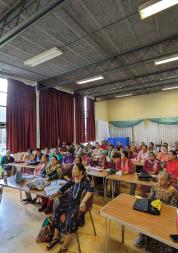Supporting Patient Participation Groups

Introduction
All GP practices in England are required to have a Patient Participation Group (PPG) that reflects the patient population served by that practice. Generally, a PPG is a group of patients registered at the practice, who work together to support the practice to develop. However, beyond this, there is no specific requirement of what constitutes a PPG, what it can do, or how it should be organised.
All GP practices in England are covered by a Primary Care Network (PCN). Primary Care Networks are groups of neighbouring local practices that work together and share funds to offer a greater range of health and care services to their patients. Greenwich has six Primary Care Networks, Heritage, River Health, Eltham Health, Blackheath & Charlton, Greenwich West, and Unity. There are opportunities for Patient Participation Groups to work with, inform, and influence new services being developed within Primary Care Networks. Indeed, if new approaches and services are to work for their local population, they need to be made with their local population.
In April 2020, we published our findings of a Greenwich GP website audit, assessing both the breadth and quality of information on practice websites. We found that not all practice websites provide PPG information. Of those that do, not all explain what a PPG is, how patients can join, when and how it meets, or what benefits it has bought to the practice and its patients.
Patient engagement is fundamental to the NHS. It is enshrined in the NHS Constitution, and is a Key Performance Indicator (KPI). Taking every opportunity to listen to patients, encouraging active participation in shaping the way services are designed and delivered, ensures better understanding of what changes and improvements are a priority from a patient’s perspective.
What we did
Our project sought to speak to PPG leads in Greenwich and specifically to:
• Map the range of ways PPGs operate
• Understand where they are working well, and why
• Describe the challenges faced by PPGs
Using a list provided by NHS South East London Clinical Commissioning Group – Greenwich, between June and July, we contacted all 33 GP practices in Greenwich. 20 responded to our request.
Half of those we spoke to were practice staff with responsibility for their PPG and half were patient chairs or lead members of their PPG Our semi-structured interviews included:
• How are patients recruited, and to what extent do PPG members reflect the patient population
• What guidelines are used, do PPG members understand their role and remit
• How do practices communicate with PPGs
• How many active8 members do PPGs have, and what form does this action take
• How did PPGs operate during the Coronavirus pandemic
• What benefits to the practice, or achievements, have PPGs delivered over the last year
Summary of findings
While some Greenwich PPGs are made up of active groups of patients, regularly in dialogue with GPs and practice staff on service developments, many more are little more than a mailing list with patients in receipt of an occasional update. These are sometimes called ‘virtual’ PPGs. Many practices struggled to keep PPGs running during Covid-19, but we did not always find evidence that PPGs were active before this.
Recruitment of PPG members is largely passive using posters in practice waiting areas and (limited) information on websites. As a result, nearly all PPGs struggle with recruitment. Most active 1 PPGs are made up of a handful of members – many of whom are elderly or retired. We did not find many examples of PPGs with members that reflect the patient population. Recruitment of younger patients (aged below 40), BAME patients, and those with long-term conditions or disabilities is a challenge.
Finding members with appropriate skills and good understanding of the role and remit of PPGs can be a problem. Some practices told us that a proportion of PPG members were reluctant to engage with issues outside of their personal health concerns and used PPG meetings to continually raise their own personal health needs. Others told us that a minority of PPG members inappropriately try to use PPG meetings and structures to lobby for their broader political views.
All practices are very positive about the potential of PPGs, but few have been able to realise these possibilities. Nearly all struggled to identify any examples of how their PPG had enhanced patient experience, service design or delivery. Indeed, several practices felt their PPG offered little value to the practice and simply added to staff workload.
Downloads
If you need this report in an alternative format, please email info@healthwatchgreenwich.co.uk

